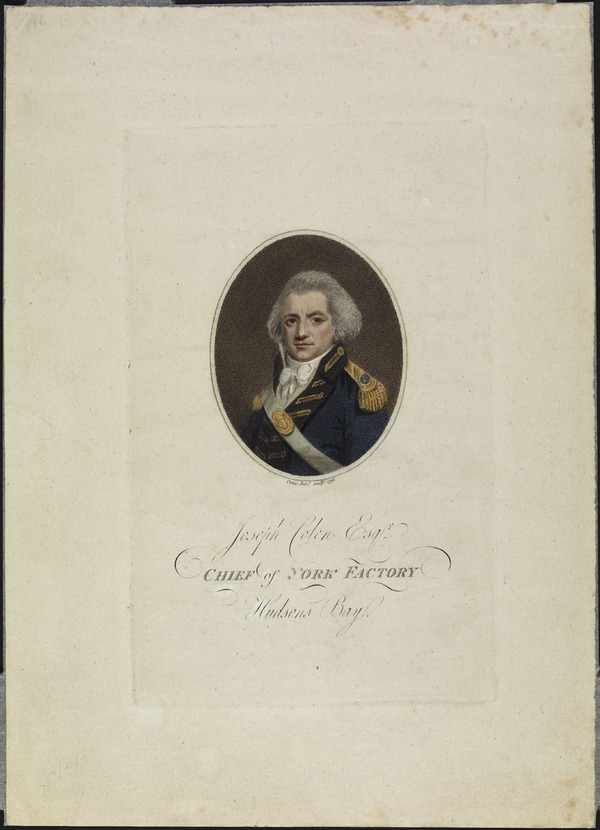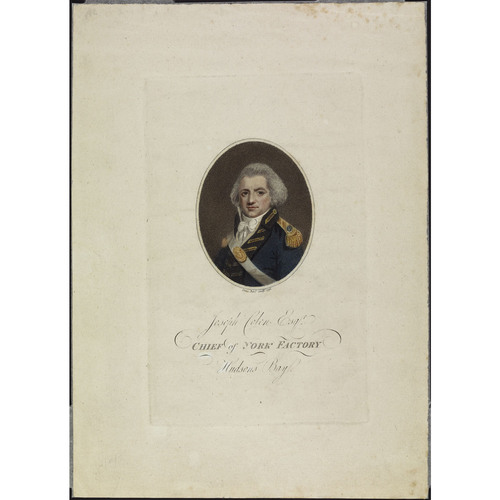COLEN, JOSEPH, HBC chief factor; b. c. 1751 in England; d. July 1818 in Cirencester, England.
In April 1785, having had extensive experience in both “mechanic & mercantile Affairs” and being “perfect master of his Pen in writing and figures,” Joseph Colen was engaged as a writer by the Hudson’s Bay Company for five years at £20 per annum. He was to assist Humphrey Marten*, chief at York Factory (Man.), and to oversee the rebuilding of the factory, destroyed in 1782 by Jean-François de Galaup*, Comte de Lapérouse – a project that was too much of a burden for the gouty Marten.
Marten retired in 1786 and William Tomison*, his successor as chief factor, was ordered to reside inland. Consequently, Colen was appointed resident chief at York at £40 per annum plus a premium on made beaver. Though in command at the factory, Colen was subject to the orders of Tomison when the latter visited York. On taking up his new appointment Colen was directed by the HBC’s London committee to forward “the building of a new Factory.” In 1793 the last flanker was covered and two years later the stockade enclosed three acres of ground, one-half of which was “occupied by buildings – The rest intended for Gardens.”
To meet the competition from the North West Company south and west of York Factory, Colen had sent men inland to establish new posts: in 1790 Charles Thomas Isham settled on Swan River (Man.) and James Spence went to Split Lake, and in 1791 William Hemmings Cook* built Chatham House on Wintering Lake. In 1794 Colen tried to organize an expedition to the Athabasca country and ordered boats for use on the inland waterways. That spring he travelled about 109 miles up the Hayes River on the first wooden boat ever to navigate inland from Hudson Bay, and there he selected a site for a provisioning depot which was to be called Gordon House. Its position considerably shortened the route travelled by the inland traders, who now needed to bring their canoes only as far as Gordon House to exchange their furs for supplies brought from York by boat.
Colen’s position as resident chief was not an easy one. Tomison did not cooperate on the Athabasca expedition, did not approve of boats, and in general tried to thwart every plan that did not benefit the posts on the Saskatchewan River. In 1794 Colen returned to London to report to the governor and committee on various aspects of the trade. When he arrived back at York the following year he had been appointed chief factor at an annual salary of £130 plus £10 for a servant. The change in status was based on the premise that Tomison would be retiring in 1795. The expected retirement did not occur, however, and that year Tomison established Fort Edmonton (Edmonton, Alta). In 1796, 1797, and 1798 Colen journeyed to Gordon House to hold councils and contract with the inland men. New posts were established and much time devoted to inland transport.
Colen was recalled by the London committee in 1798; his salary was terminated in March 1799. The reasons were not stated, but one was the impatience of the committee with the jealousy and rivalry between Colen and Tomison. In conducting affairs at York Colen was hampered by his lack of knowledge of inland operations, and he was lax in overseeing the accounting of the York Factory goods and provisions. In fairness to Colen it should be said that he was a man of ideas, an innovator and a thinker, rather than a shrewd businessman. These characteristics are demonstrated by his interests in medicine, tree husbandry, the distilling operation at York, and the collecting of shrubs for London, and by his possessing at York Factory a personal library of some 1,400 volumes.
On his retirement from the company Colen apparently did not return to business life, but he was an active member of the Society for the Encouragement of Arts, Manufactures, and Commerce, in London. Sought out in 1802 by Lord Selkirk [Douglas] for an opinion on his scheme to introduce Scottish emigrants to present-day Manitoba through Hudson Bay, Colen gave a favourable opinion. Colen appears to have spent the last ten years of his life in Cirencester.
PAM, HBCA, A.1/46: f.51; A.1/47: ff.58, 126; A.5/2: ff.127d, 147d, 148–49; A.5/3: ff.46, 56d, 83, 136; A.5/4: ff.51–51d; A.6/13: ff.156–56d; A.6/15: ff.23, 64, 137; A.6/16: f.54d; A.11/116: ff.87, 129, 133; A.11/117: ff.59d, 114d–15; B.239/a/85: f.44; B.239/a/91: ff.4, 6–6d, 10–10d, 31d, 33; B.239/a/95: ff.17d, 20d; B.239/a/96: ff.l, 8d, 9d, 27d, 30d, 32d, 33–34, 40d, 58d; B.239/a/99: ff.3, 6–6d, 15d–16; B.239/a/100: ff.15d–16, 23–24, 26–26d; B.239/a/102: ff.3, 6, 7d, 39d; B.239/b/58: ff.116–17, 126–27d; B.239/b/79: ff.2d–4; F.3/2: ff.63d–64. Royal Soc. Arch. (London), MC 1 (40), Joseph Colen to Joseph Banks, 29 Dec. 1811 (transcript at PAM, HBCA). Gentleman’s Magazine, July–December 1818: 88. Journals of Hearne and Turnor (Tyrrell), 593. Saskatchewan journals and correspondence: Edmonton House, 1795–1800; Chesterfield House, 1800–1802, ed. A. M. Johnson (London, 1967). Soc. for the Encouragement of Arts, Manufactures, and Commerce, Trans. (London), 13 (1795)–22 (1804).
Cite This Article
Shirlee Anne Smith, “COLEN, JOSEPH,” in Dictionary of Canadian Biography, vol. 5, University of Toronto/Université Laval, 2003–, accessed January 21, 2025, https://www.biographi.ca/en/bio/colen_joseph_5E.html.
The citation above shows the format for footnotes and endnotes according to the Chicago manual of style (16th edition). Information to be used in other citation formats:
| Permalink: | https://www.biographi.ca/en/bio/colen_joseph_5E.html |
| Author of Article: | Shirlee Anne Smith |
| Title of Article: | COLEN, JOSEPH |
| Publication Name: | Dictionary of Canadian Biography, vol. 5 |
| Publisher: | University of Toronto/Université Laval |
| Year of revision: | 1983 |
| Access Date: | January 21, 2025 |




